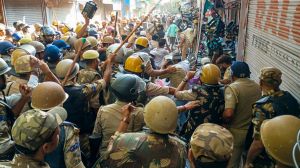Weekend deluge — Lack of civic sense was the saboteur
MUMBAI, June 29: If Saturday's torrential downpour, which brought Mumbai to its knees yet again cast a cynical eye on the city's disaster ma...

MUMBAI, June 29: If Saturday’s torrential downpour, which brought Mumbai to its knees yet again cast a cynical eye on the city’s disaster management plan, the state administration says it is grappling with muck of a different — and more insidious — kind.
As long as Mumbai’s citizens continue to dump household waste on to the streets, in open storm water drains and nallahs, water-logging and the consequent havoc it wreaks are here to stay. The bottomline: the Mumbaikar’s woeful lack of civic sense will inevitably sabotage even the most comprehensive disaster management plan.
Additional Chief Secretary, K C Srivastava, who heads the high-level committee preparing a disaster management action plan for the metropolis, says the civic and government machinery responded to the crisis with alacrity this time. “The response time taken by the various agencies involved was very quick compared to last year when Mumbai was inundated on August 21.” This year, the Brihanmumbai Electric Supply and Transportundertaking plied special buses from CST, with some going all the way to Vashi. Buses were also operated from Churchgate to Bandra to help stranded commuters along their way.
“Last year, the railways took about 10 hours to begin even skeletal services, but suburban services, which collapsed at around 6.30 pm on Saturday, were resumed by midnight,” Srivastava points out.
He says reports dispatched to his office by the Brihanmumbai Municipal Corporation (BMC) indicate that 80 per cent of the storm water drains and nallahs were cleaned by May 27. “Of course, we cannot rule out corruption and other malpractices in awarding contracts for the annual cleaning of nallahs, but it is not true that the nallahs are not cleaned at all,” Srivastava says.
The city’s severe water-logging problem, though, will not dissipate in a hurry. The entire underground drainage system, designed more than a century ago, is simply not equipped to handle the current load. Coupled with high tide conditions during the monsoon andencroachments along the railway tracks, it is bound to choke time and again, civic engineers say.
Moreover, the nallahs and storm water drains are used as community garbage bins by Mumbai’s citizens, who think nothing of chucking a large portion of the 55,000 tonnes of solid waste generated daily into them. Following the cleanliness drive since January 1997, the BMC has placed garbage bins all over the city but few actually take pains to use them.
Plastic carry bags, in particular, are a bane. In fact, the civic administration has written to the state government seeking a ban on their use.







- 01
- 02
- 03
- 04
- 05
























